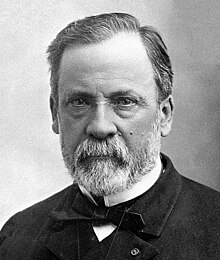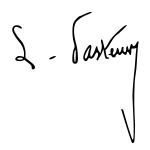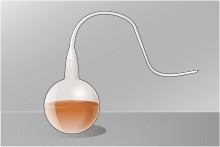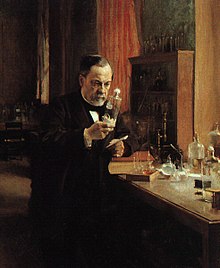Louis Pasteur
Louis Pasteur | |
|---|---|
 French microbiologist and chemist | |
| Born | December 27, 1822 |
| Died | September 28, 1895 (aged 72) |
| Nationality | |
| Alma mater | École Normale Supérieure |
| Scientific career | |
| Fields | Chemistry Microbiology |
| Institutions | Dijon Lycée University of Strasbourg Université Lille Nord de France École Normale Supérieure |
| Signature | |
 | |
Louis Pasteur (pronounced [pastøʁ] December 27, 1822 – September 28, 1895) was a French chemist and microbiologist born in Dole. He is remembered for his remarkable breakthroughs in the causes and preventions of disease. His discoveries reduced mortality from puerperal fever, and he created the first vaccine for rabies. His experiments supported the germ theory of disease. He was best known to the general public for inventing a method to stop milk and wine from causing sickness, a process that came to be called pasteurization. He is regarded as one of the three main founders of microbiology, together with Ferdinand Cohn and Robert Koch. Pasteur also made many discoveries in the field of chemistry, most notably the molecular basis for the asymmetry of certain crystals.[1] His body lies beneath the Institute Pasteur in Paris in a spectacular vault covered in depictions of his accomplishments in Byzantine mosaics.[2]
Early life and biography
Louis Pasteur was born on December 27, 1822, in Dole in the Jura region of France, into the family of a poor tanner. Louis grew up in the town of Arbois.[1] He gained degrees in Letters and in Mathematical Sciences before entering the École Normale Supérieure, an elite college. After serving briefly as professor of physics at Dijon Lycée in 1848, he became professor of chemistry at the University of Strasbourg,[1] where he met and courted Marie Laurent, daughter of the university's rector, in 1849. They were married on May 29, 1849, and together had five children, only two of whom survived to adulthood, two died of typhoid and one of a brain tumor. These personal tragedies inspired Pasteur to try to find cures for diseases such as typhoid.
Work on chirality and the polarization of light

In Pasteur's early work as a chemist, he resolved a problem concerning the nature of tartaric acid (1849). A solution of this compound derived from living things (specifically, wine lees) rotated the plane of polarization of light passing through it. The mystery was that tartaric acid derived by chemical synthesis had no such effect, even though its chemical reactions were identical and its elemental composition was the same.[1]
Upon examination of the minuscule crystals of sodium ammonium tartrate, Pasteur noticed that the crystals came in two asymmetric forms that were mirror images of one another. Tediously sorting the crystals by hand gave two forms of the compound: solutions of one form rotated polarized light clockwise, while the other form rotated light counterclockwise. An equal mix of the two had no polarizing effect on light. Pasteur correctly deduced the molecule in question was asymmetric and could exist in two different forms that resemble one another as would left- and right-hand gloves, and that the biological source of the compound provided purely the one type.[3] This was the first time anyone had demonstrated chiral molecules.
Pasteur's doctoral thesis on crystallography attracted the attention of M. Puillet and he helped Pasteur garner a position of professor of chemistry at the Faculté (College) of Strasbourg.[1]
In the year of 1854, Louis was named Dean of the new Faculty of Sciences in Lille. In 1856, he was made administrator and director of scientific studies of the École Normale Supérieure.[1]
Germ theory
Pasteur demonstrated that fermentation is caused by the growth of microorganisms, and that the emergent growth of bacterium in nutrient broths is not due to spontaneous generation[1] but rather to biogenesis (Omne vivum ex ovo).


He exposed boiled broths to air in vessels that contained a filter to prevent all particles from passing through to the growth medium, and even in vessels with no filter at all, with air being admitted via a long tortuous tube that would not allow dust particles to pass. Nothing grew in the broths unless the flasks were broken open; therefore, the living organisms that grew in such broths came from outside, as spores on dust, rather than spontaneously generated within the broth. This was one of the last and most important experiments disproving the theory of spontaneous generation. The experiment also supported germ theory.[1]
While Pasteur was not the first to propose germ theory (Girolamo Fracastoro, Agostino Bassi, Friedrich Henle and others had suggested it earlier), he developed it and conducted experiments that clearly indicated its correctness and managed to convince most of Europe it was true. Today he is often regarded as the father of germ theory and bacteriology, together with Robert Koch.[4]
Pasteur's research also showed that the growth of microorganisms was responsible for spoiling beverages, such as beer, wine and milk. With this established, he invented a process in which liquids such as milk were heated to kill most bacteria and molds already present within them. He and Claude Bernard completed the first test on April 20, 1862. This process was soon afterwards known as pasteurization.[4]
Beverage contamination led Pasteur to the idea that microorganisms infecting animals and humans cause disease. He proposed preventing the entry of microorganisms into the human body, leading Joseph Lister to develop antiseptic methods in surgery.
In 1865, two parasitic diseases called pébrine and flacherie were killing great numbers of silkworms at Alais (now Alès). Pasteur worked several years proving it was a microbe attacking silkworm eggs which caused the disease, and that eliminating this microbe within silkworm nurseries would eradicate the disease.[4][1]
Pasteur also discovered anaerobiosis, whereby some microorganisms can develop and live without air or oxygen, called the Pasteur effect.
Immunology and vaccination
Pasteur's later work on diseases included work on chicken cholera. During this work, a culture of the responsible bacteria had spoiled and failed to induce the disease in some chickens he was infecting with the disease. Upon reusing these healthy chickens, Pasteur discovered that he could not infect them, even with fresh bacteria; the weakened bacteria had caused the chickens to become immune to the disease, even though they had only caused mild symptoms.[1][4]
His assistant Charles Chamberland (of French origin) had been instructed to inoculate the chickens after Pasteur went on holiday. Chamberland failed to do this, but instead went on holiday himself. On his return, the month old cultures made the chickens unwell, but instead of the infection being fatal, as it usually was, the chickens recovered completely. Chamberland assumed an error had been made, and wanted to discard the apparently faulty culture when Pasteur stopped him. Pasteur guessed the recovered animals now might be immune to the disease, as were the animals at Eure-et-Loir that had recovered from anthrax.[5]
In the 1870s, he applied this immunization method to anthrax, which affected cattle, and aroused interest in combating other diseases.

Pasteur publicly claimed he had made the anthrax vaccine by exposing the bacillus to oxygen. His laboratory notebooks, now in the Bibliotheque Nationale in Paris, in fact show Pasteur used the method of rival Jean-Joseph-Henri Toussaint, a Toulouse veterinary surgeon, to create the anthrax vaccine.[3][6] This method used the oxidizing agent potassium dichromate. Pasteur's oxygen method did eventually produce a vaccine but only after he had been awarded a patent on the production of an anthrax vaccine.
The notion of a weak form of a disease causing immunity to the virulent version was not new; this had been known for a long time for smallpox. Inoculation with smallpox was known to result in far less scarring, and greatly reduced mortality, in comparison with the naturally acquired disease. Edward Jenner had also discovered vaccination, using cowpox to give cross-immunity to smallpox (in 1796), and by Pasteur's time this had generally replaced the use of actual smallpox material in inoculation. The difference between smallpox vaccination and cholera and anthrax vaccination was that the weakened form of the latter two disease organisms had been generated artificially, and so a naturally weak form of the disease organism did not need to be found.
This discovery revolutionized work in infectious diseases, and Pasteur gave these artificially weakened diseases the generic name of vaccines, to honor Jenner's discovery. Pasteur produced the first vaccine for rabies by growing the virus in rabbits, and then weakening it by drying the affected nerve tissue.
The rabies vaccine was initially created by Emile Roux, a French doctor and a colleague of Pasteur who had been working with a killed vaccine produced by desiccating the spinal cords of infected rabbits. The vaccine had only been tested on eleven dogs before its first human trial.[3][1]
This vaccine was first used on 9-year old Joseph Meister, on July 6, 1885, after the boy was badly mauled by a rabid dog.[3] This was done at some personal risk for Pasteur, since he was not a licensed physician and could have faced prosecution for treating the boy. However, left without treatment, the boy faced almost certain death from rabies. After consulting with colleagues, Pasteur decided to go ahead with the treatment. The treatment proved to be a spectacular success, with Meister avoiding the disease; thus, Pasteur was hailed as a hero and the legal matter was not pursued. The treatment's success laid the foundations for the manufacture of many other vaccines. The first of the Pasteur Institutes was also built on the basis of this achievement.[3]
Legal risk was not the only kind Pasteur undertook. In The Story of San Michele, Axel Munthe writes of the rabies vaccine research:
Pasteur himself was absolutely fearless. Anxious to secure a sample of saliva straight from the jaws of a rabid dog, I once saw him with the glass tube held between his lips draw a few drops of the deadly saliva from the mouth of a rabid bull-dog, held on the table by two assistants, their hands protected by leather gloves.

Because of his study in germs, Pasteur encouraged doctors to sanitize their hands and equipment before surgery. Prior to this, few doctors or their assistants practiced the procedure of washing their hands and equipment.
Allegations of deception
In 1995, the centennial of the death of Louis Pasteur, the New York Times ran an article titled "Pasteur's Deception". After having thoroughly read Pasteur's lab notes the science historian Gerald L. Geison declared that Pasteur had given a misleading account of the preparation of the anthrax vaccine used in the experiment at Pouilly-le-Fort.[7]
Faith and spirituality
Catholic observers often said that Louis Pasteur remained through out his whole life an ardent Christian. According to his grandson Pasteur Vallery-Radot, however, Pasteur had only kept from his Catholic background a spiritualism without religious practice. The well-known quotation attributed to Pasteur: "The more I know, the more nearly is my faith that of the Breton peasant. Could I but know all I would have the faith of a Breton peasant's wife."[1] would be apocryphal.[8] Maurice Vallery-Radot, grandson of the brother of the son-in-law of Pasteur and outspoken Catholic, holds that Pasteur fundamentally remained catholic, but does not claim that he went to mass.[9]
Principal works
Pasteur's principal works are: "Etudes sur le Vin", (1866); "Etudes sur le Vinnaigre" (1868); "Etudes sur la Maladie des Vers à Soie" (2 vols., 1870); "Quelques Réflexions sur la Science en France" (1871); "Etudes sur la Bière" (1876); "Les Microbes organisés, leur rôle dans la Fermentation, la Putréfaction et la Contagion" (1878); "Discours de Réception de M.L. Pasteur à l'Académie Française" (1882); "Traitement de la Rage" (1886).[1]
Honors and final days
His death occurred in 1895, near Paris, from complications of a series of strokes that had started in 1868.[3] He died while listening to the story of St Vincent de Paul, whom he admired and sought to emulate.[1] He was buried in the Cathedral of Notre Dame, but his remains were reinterred in a crypt in the Institut Pasteur, Paris, where he is remembered for his life-saving work.
Pasteur won the Leeuwenhoek medal, microbiology's highest Dutch honor in Arts and Sciences, in 1895. He was a Grand Croix of the Legion of Honor–one of only 75 in all of France. Both Institute Pasteur and Université Louis Pasteur were named after him.
In many localities worldwide, there are streets named in his honor. For example, in the USA: the Medical school at Stanford University, Palo Alto and Irvine, California, Boston, Massachusetts and Polk, Florida, adjacent to the University of Texas Health Science Center at San Antonio; Jonquière, Québec; San Salvador de Jujuy and Buenos Aires (Argentina), Yarmouth and Norfolk in the United Kingdom, Jericho and Wulguru in Queensland, (Australia); Phnom Penh in Cambodia; Ho Chi Minh City in Vietnam; Batna in Algeria; Bandung in Indonesia, Tehran in Iran, Milan in Italy and Cluj-Napoca and Bucharest in Romania.
Statements
In his triumphal lecture at the Sorbonne in 1864, Pasteur said "Never will the doctrine of spontaneous generation recover from the mortal blow struck by this simple experiment" (referring to his swan-neck flask experiment wherein he proved that fermenting microorganisms would not form in a flask containing fermentable juice until an entry path was created for them).[3][10][11]
See also
- Infection control
- Infectious disease
- Modern medicine
- Pasteur Institute
- The Story of Louis Pasteur (a 1936 biographical film).
Notes
- ^ a b c d e f g h i j k l m n James J. Walsh (1913). . In Herbermann, Charles (ed.). Catholic Encyclopedia. New York: Robert Appleton Company.
- ^ Campbell, D. M. (January, 1915). "The Pasteur Institute of Paris". American Journal of Vetrinary Medicine. 10 (1). Chicago, Ill.: D. M. Campbell: 29–31. Retrieved February 8, 2010.
{{cite journal}}: Check date values in:|date=(help) - ^ a b c d e f g
David V. Cohn (December 18, 2006). "Pasteur". University of Louisville. Retrieved 2007-12-02.
Fortunately, Pasteur's colleagues Chamberlain [sic] and Roux followed up the results of a research physician Jean-Joseph-Henri Toussaint who reported a year earlier that carbolic-acid/heated anthrax serum would immunize against anthrax. These results were difficult to reproduce and discarded although, as it turned out, Toussaint was on the right track. This led Pasteur and his assistants to substitute an anthrax vaccine prepared by a method not dissimilar to that of Toussaint and different from what Pasteur had announced.
- ^ a b c d Ullmann, Agnes (August 2007). "Pasteur-Koch: Distinctive Ways of Thinking about Infectious Diseases". Microbe (American Society for Microbiology). 2 (8): 383–7. Retrieved December 12, 2007.
- ^ Sternberg, George M. (1901). A Textbook of Bacteriology. New York: William Wood and Company. pp. 278–9.
- ^ Adrien Loir (1938). Le mouvement sanitaire. pp. 18, 160.
{{cite book}}: Unknown parameter|chapter_title=ignored (|chapter=suggested) (help) - ^ See Gerald Geison, The Private Science of Louis Pasteur, Princeton University Press, 1995. ISBN 069101552X.
- ^ Pasteur Vallery-Radot, Letter to Paul Dupuy, 1939, quoted by Hilaire Cuny, Pasteur et le mystère de la vie, Paris, Seghers, 1963, p. 53–54. Patrice Pinet, Pasteur et la philosophie, Paris, 2005, p. 134–135, quotes analogous assertions of Pasteur Vallery-Radot, with references to Pasteur Vallery-Radot, Pasteur inconnu, p. 232, and André George, Pasteur, Paris, 1958, p. 187. According to Maurice Vallery-Radot (Pasteur, 1994, p. 378), the false quotation appeared for the first time in the Semaine religieuse .... du diocèse de Versailles, 6 October 1895, p. 153, shortly after the death of Pasteur.
- ^ Vallery-Radot, Maurice (1994). Pasteur. Paris: Perrin. pp. 377–407.
- ^ Fox, Sidney W. (1972). Molecular Evolution and the Origin of Life. W.H Freeman and Company, San Francisco. p. 4.171. ISBN 0824766199.
{{cite book}}: Unknown parameter|coauthors=ignored (|author=suggested) (help) - ^ Oparin, Aleksandr I. (1953). Origin of Life. Dover Publications, New York. p. 196. ISBN 0486602133.
References
- Debré, P. (1998). Louis Pasteur. Baltimore, MD: Johns Hopkins University Press. ISBN 0-8018-5808-9.
{{cite book}}: Unknown parameter|coauthors=ignored (|author=suggested) (help) - Geison, Gerald L. (1995). The private science of Louis Pasteur. Princeton, NJ: Princeton University Press. ISBN 0-691-03442-7.
- Latour, Bruno (1988). The Pasteurization of France. Boston: Harvard University Press. ISBN 0-674-65761-6.
- Tiner, John Hudson (1990). Louis Pasteur: Founder of Modern Medicine. Fenton, MI: Mott Media. ISBN 0-88062-159-1.
External links
- The Institut Pasteur - Foundation Dedicated to the prevention and treatment of diseases through biological research, education and public health activities
- The Pasteur Foundation - A US nonprofit organization dedicated to promoting the mission of the Institut Pasteur in Paris. Full archive of newsletters available online containing examples of US Tributes to Louis Pasteur.
- Pasteur's Papers on the Germ Theory
- Pasteur's Work on Beer Brewing
- The Pasteur Galaxy
- Louis Pasteur featured on the 5 French Franc banknote from 1966.
- Germ Theory and Its Applications to Medicine and Surgery, 1878
- LIFE magazine's top 100 events of the millennium: Germ theory of disease and Pasteur
- Louis Pasteur (1822-1895) profile, AccessExcellence.org
The complete work of Pasteur, BNF (Bibliothèque nationale de France)
- Template:PDF Template:Fr icon
- Template:PDF Template:Fr icon
- Comptes rendus de l’Académie des sciences Articles published by Pasteur Template:Fr icon
- 1822 births
- 1895 deaths
- People from Dole
- Louis Pasteur
- French biologists
- French microbiologists
- French chemists
- Vaccinologists
- People in the history of medicine
- Alumni of the École Normale Supérieure
- Université Lille Nord de France faculty
- University of Strasbourg faculty
- Members of the Académie française
- Members of the French Academy of Sciences
- Foreign Members of the Royal Society
- Members of the National Academy of Sciences
- Members of the Russian Academy of Sciences
- National Inventors Hall of Fame inductees
- Légion d'honneur recipients
- Recipients of the Copley Medal
- French humanitarians
- Roman Catholics
- French Roman Catholics
- Deaths from stroke
